A Weekend at Wenderholm: Winkelmann and the Whitneys, 16–18 September 1899
In September 1899 Henry Winkelmann visited his friends the Whitneys at Wenderholm, Wairewa. Their house (named Wenderholm by its first owner Robert Graham and now known as Couldrey House) still exists, incorporated into Wenderholm Regional Park north of Auckland, and open to the public.
During his visit Winkelmann made a number of photographs, (now in the collection of Auckland War Memorial Museum Tāmaki Paenga Hira) including the group below on a veranda. Winkelmann has contrived to be in this picture (either by using a self-timing mechanism or perhaps by getting someone else to trip his camera's shutter release). From left are: a fellow-visitor to the house, General Hogge (Major-General Somerville George Cameron Hogge, 1837-1911)1; Winkelmann (playing a zither); Mrs Harriet Whitney; and one of the Whitney's three daughters, perhaps Amelia Viola Whitney (see the section 'Who were the Misses Whitney?' below). Alas, the names of the dogs have not come down to us.
Mrs and Miss Whitney, General Hogge and H. Winkelmann, Wenderholm, Waiwera
1899 (Henry Winkelmann) – 2025
Click on image to toggle transition between two photographs


16 Sep 1899 image: Henry Winkelmann. Mrs and Miss Whitney, General Hogge and H. Winkelmann, Wenderholm, Waiwera. Auckland War Memorial Museum Tāmaki Paenga Hira. PH-NEG-863.
Click here for a fullscreen version of this transition.
At first glance this picture seems to be a fairly conventional group photograph, until one notices that one of the dogs is wearing glasses and appears to be reading. We don't know who had this bright idea but Winkelmann must be the prime suspect; it fits well with his sometimes playful sense of humour, very often evident in photographs in which he features.
It seems that Winkelmann made two similar group photographs in the same session on this veranda, one of them now lost; in his negative register (see below) he described the missing image as "[64]2. Group Mrs and Misses Whitney & General Hogge" and on the next line of the register "[64]3. [two iteration marks] & H Winkelmann" this being the picture used here. (Might one of the Whitney daughters present have tripped the shutter for this Winkelmann "selfie"?)2
Below: Details from Winkelmann's half-plate negative.
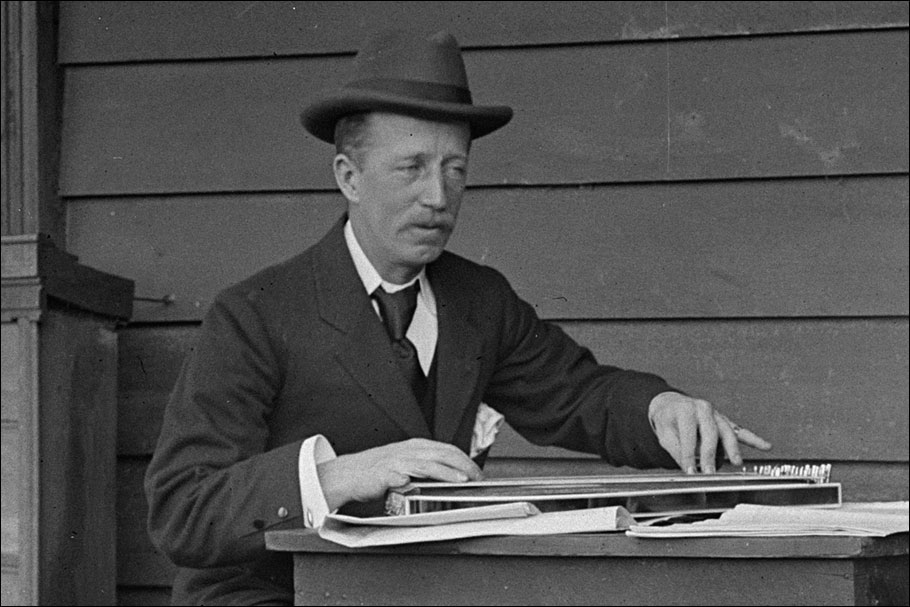
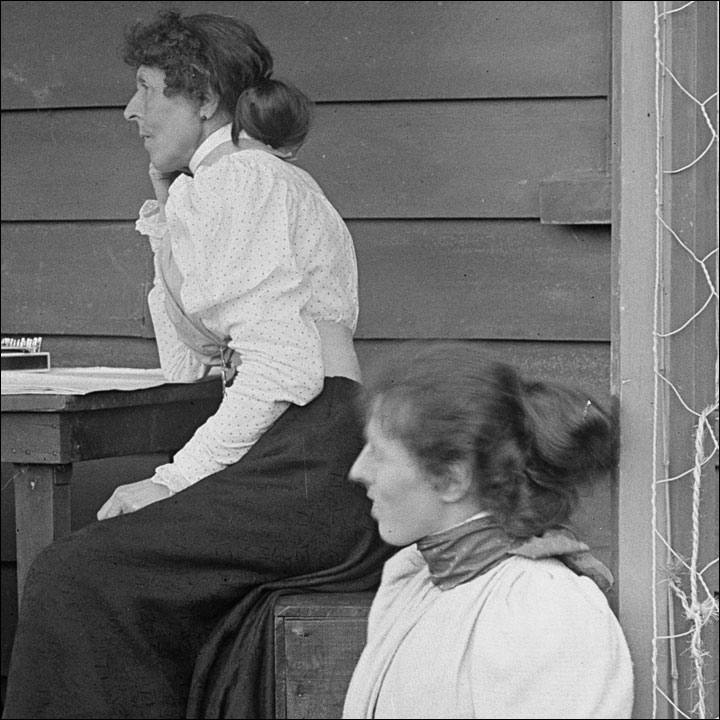
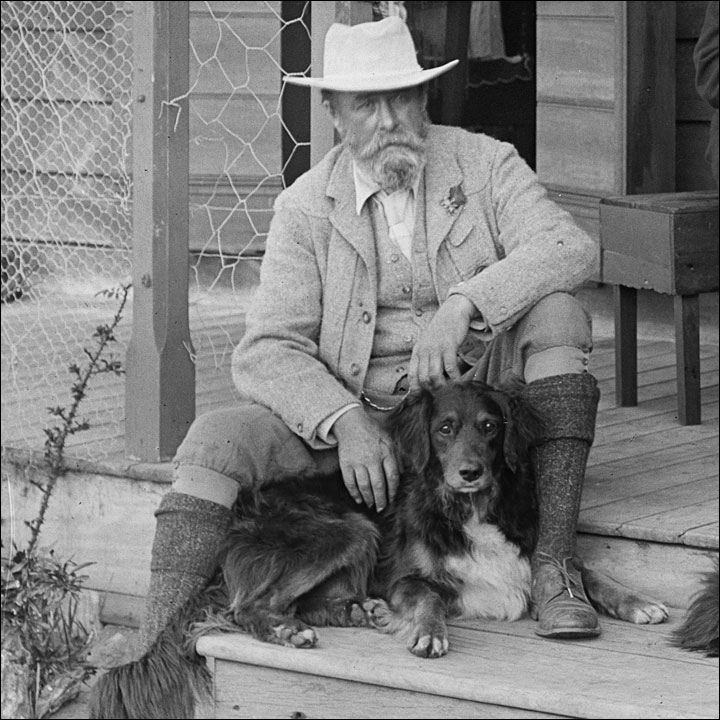

Below: A detail of the relevant page from Winkelmann's negative register. Entries not underlined in red in this register are missing—in this case plate 642 (for my colour-blind readers). The two exposures discussed above are 642 and 643. Winkelmann's use of iteration (or ditto) marks here is slightly confusing, but it's clear that the two women in plate 643 are Mrs Harriet Whitney and one of her daughters.
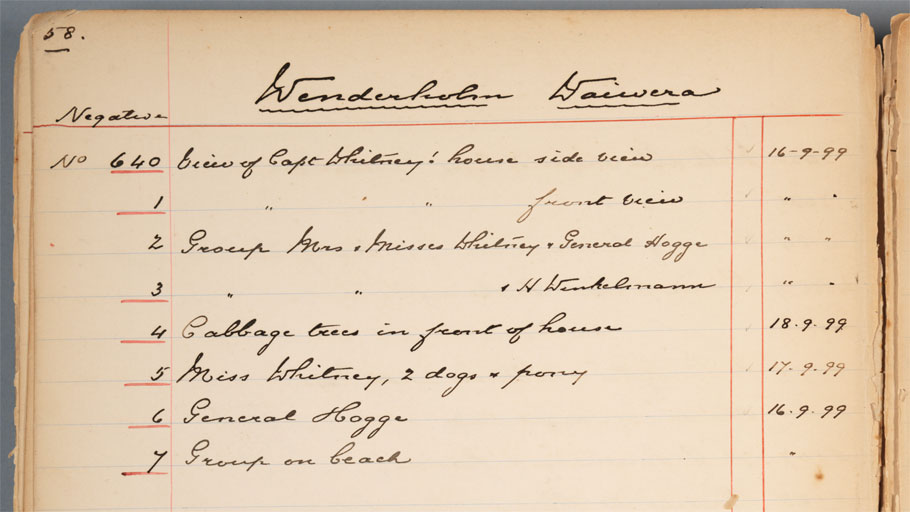
Auckland War Memorial Museum Tāmaki Paenga Hira. MS-2000-67-9-page-58, detail.
Below: The Whitney house viewed from the front, an exposure also made on 16 September (a Saturday). Winkelmann plate number 641.
Wenderholm, Wairewa. View of Captain Whitney's house (front view)
Click on image to toggle transition between two photographs
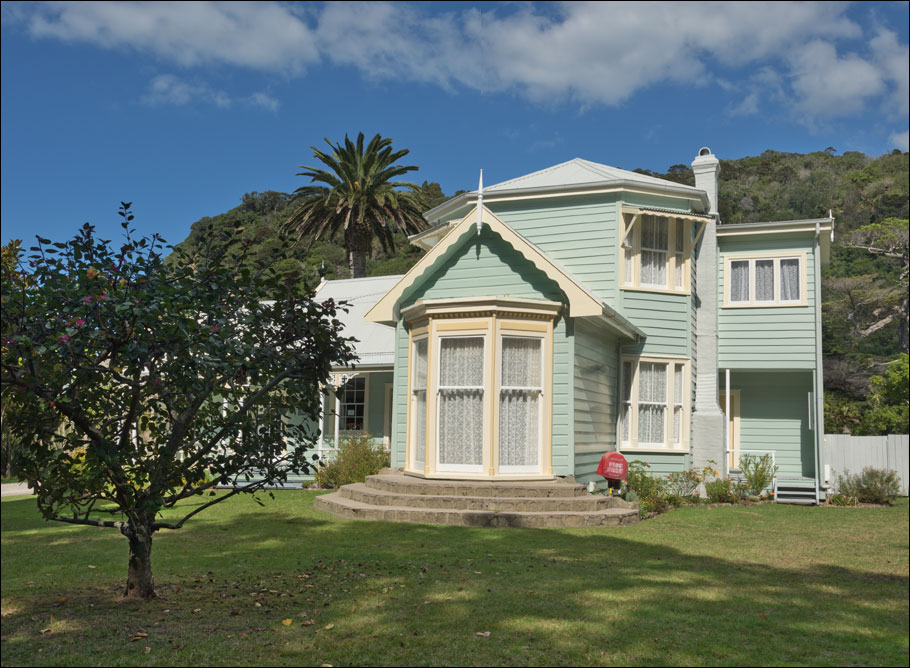
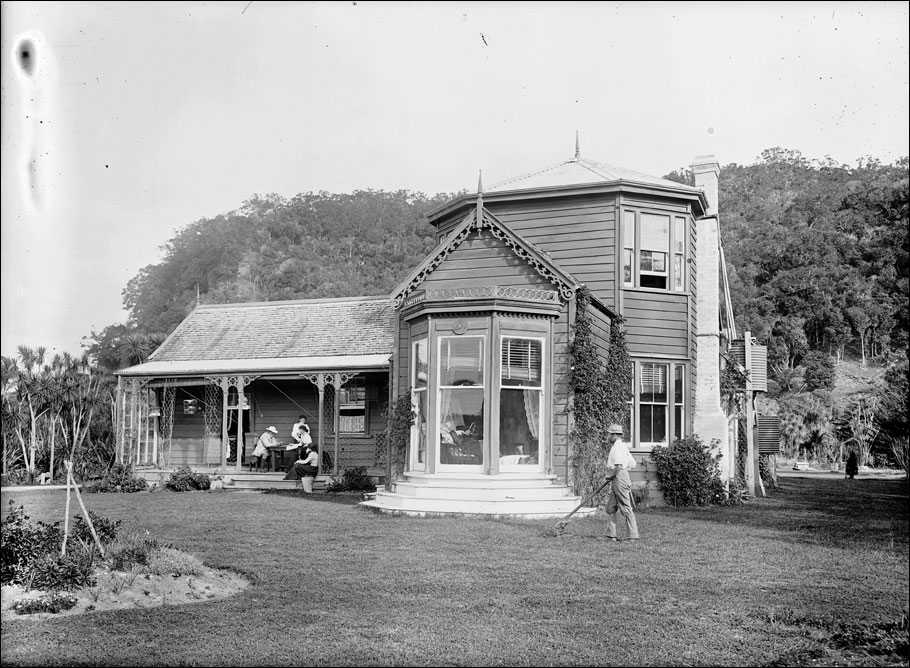
16 Sep 1899 image: Henry Winkelmann. Wenderholm, Waiwera. View of Capt. Whitney's house front view. Auckland War Memorial Museum Tāmaki Paenga Hira. PH-NEG-862.
Click here for a fullscreen version of this transition.
Below: A detail from plate 641 showing General Hogge, Mrs Harriet Whitney (seated at the table) and two Whitney daughters. I assume that the standing figure is Alice Whitney (see 'Who were the Misses Whitney?' below). Judging by the shadows of the posts on the wall of the approximately north-facing veranda, the dog-with-glasses group seems to have been taken a little while after this picture on the Saturday afternoon—note the sundial mounted above the window in the second detail below.
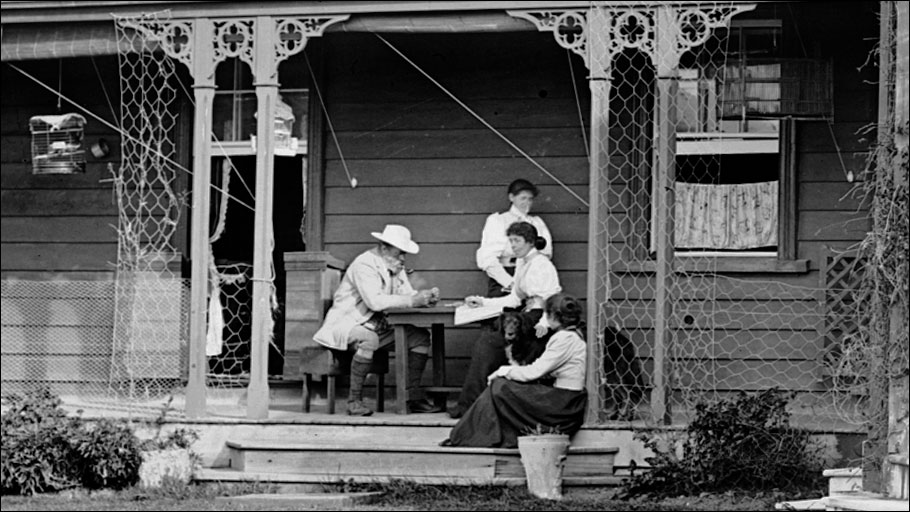
Below: Another detail showing a woman reading inside the house (another visitor or house guest presumably, possibly a certain Mrs Gordon—see the group on beach picture below). Unsurprisingly, the man mowing the lawn is also unidentified.

Below: The Whitney house viewed from the east, showing Captain John Whitney with horses, an exposure also made on 16 September. Winkelmann plate number 640.
Wenderholm, Wairewa. View of Captain Whitney's house (side view)
Click on image to toggle transition between two photographs


16 Sep 1899 image: Henry Winkelmann. Wenderholm, Waiwera. View of Capt. Whitney's house side view. Auckland War Memorial Museum Tāmaki Paenga Hira. PH-NEG-861.
Click here for a fullscreen version of this transition.
The only one of Winkelmann's photographs made during this visit that features his host Captain Whitney, poorly seen at this distance from the camera with his face shaded and somewhat blurred by movement. (For a 1907 portrait of John Whitney see the foot of this page.) The porch where Winkelmann photographed General Hogge, now gone, is visible facing the camera on the right section of the house. Below: A detail from this plate.
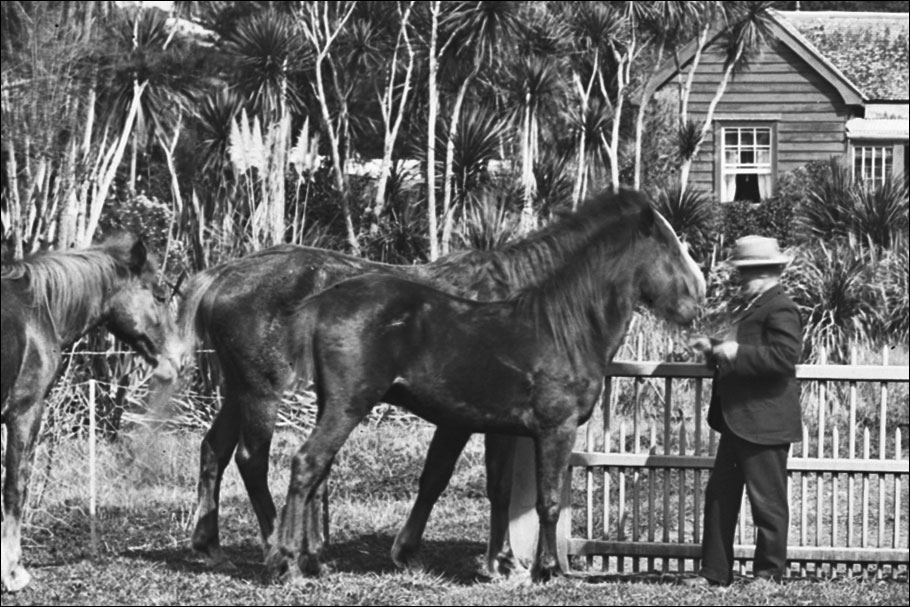
Below: A group photograph made on the Saturday afternoon. Winkelmann plate number 647.
Wenderholm, Waiwera. Group on beach
Click on image to toggle transition between two photographs
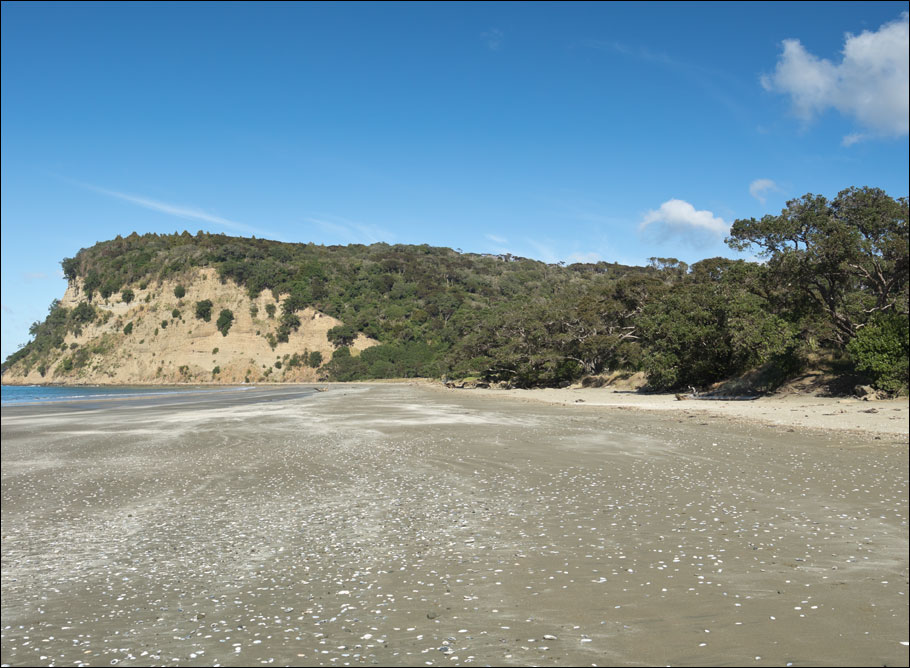

16 Sep 1899 image: Henry Winkelmann. Wenderholm, Waiwera. Group on beach. Auckland War Memorial Museum Tāmaki Paenga Hira. PH-NEG-867.
Click here for a fullscreen version of this transition.
Auckland Museum's description of this picture states "Four women, (includes 2 Misses Whitney and Mrs Gordon)"3. Clearly at left are the two Misses Whitney—I assume Alice (with parasol) and Amelia (see 'Who were the Misses Whitney?' below); the woman at far right is also clearly Harriet Whitney, so "Mrs Gordon" must be third from left (she is the woman seen reading in Winkelmann's photograph of the front of the house above). Below: A detail from this plate.

Below: A picture made the following day, Sunday 17 September (which seems to have been a day of rest, for Winkelmann at least; this is the only picture he recorded making that day). Winkelmann plate number 645.
Miss Whitney
Click on image to toggle transition between two photographs
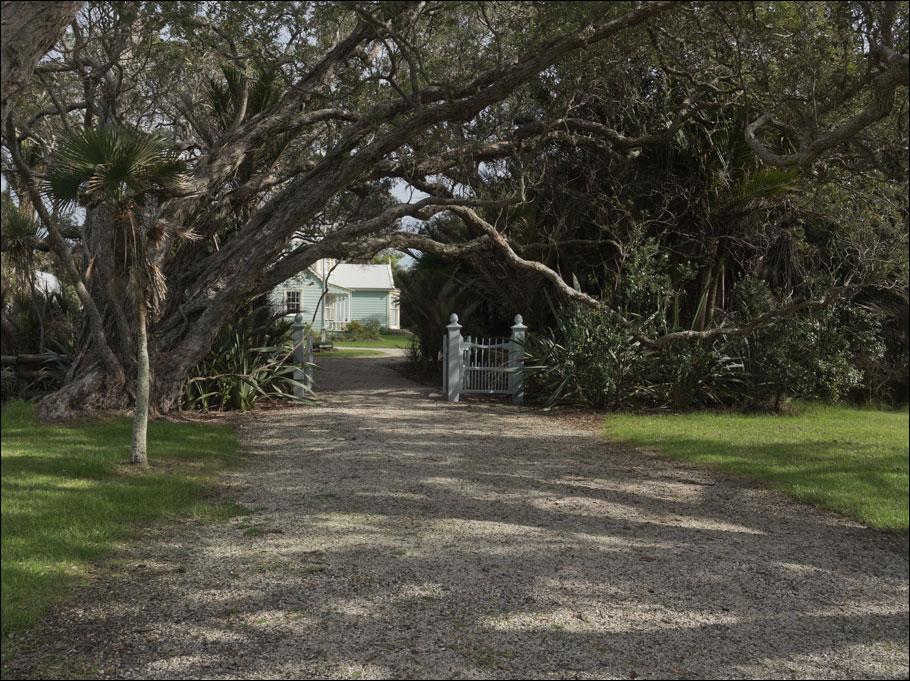
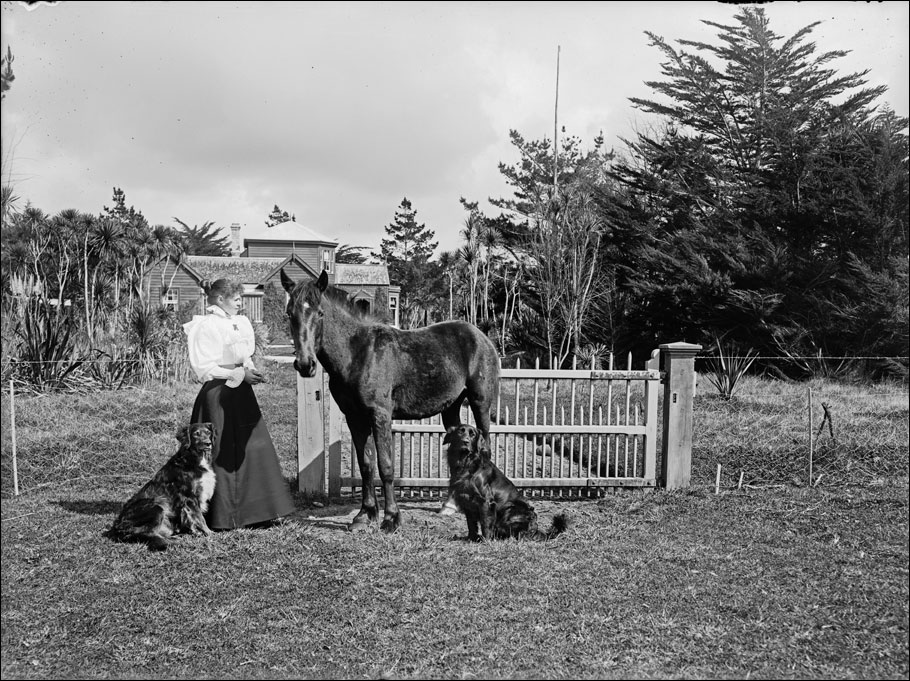
17 Sep 1899 image: Henry Winkelmann. Miss Whitney. Auckland War Memorial Museum Tāmaki Paenga Hira. PH-NEG-865.
Click here for a fullscreen version of this transition.
For reasons outlined below I think this must be the Whitney's youngest daughter, Alice. Below: A detail from this plate.

The unfortunate case of "Mr" Whitney
Years ago, confusion arose around the dog-with-glasses picture in the mistaken identification of the man at left as "Mr" Whitney. Auckland Museum at some point gave it the title "Wenderholm, Waiwera. Mr and Misses Whitney and H. Winkelmann". This was odd, as the Museum correctly identified Hogge—obviously the same man seen in the group shot—in a picture Winkelmann made of him on the same day (plate 646), wearing the same distinctive outfit, sitting in a porch. (The General appears to be reading something very like the document being "read" by the dog in plate 643.)
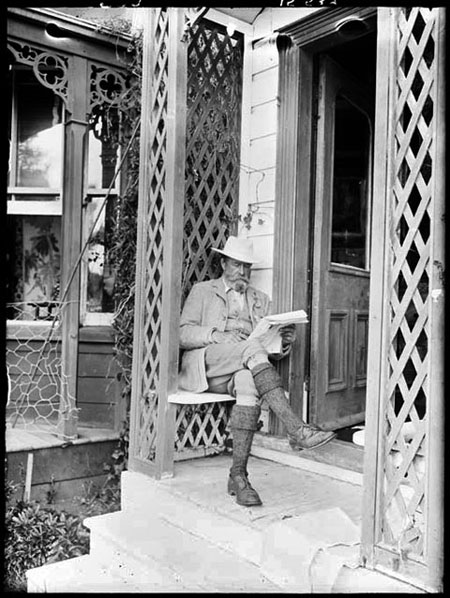
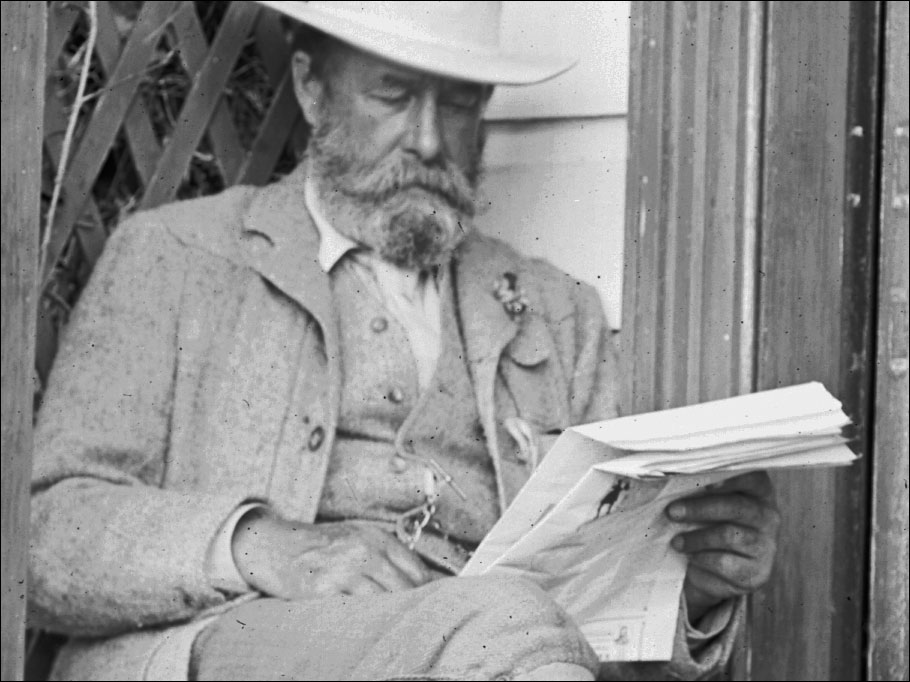
Henry Winkelmann (16 Sep 1899). Wenderholm, Waiwera. General Hogge. Auckland War Memorial Museum Tāmaki Paenga Hira. PH-NEG-15537
Below is the reverse of an Auckland Museum file print, undated, of the dog-with-glasses picture. Could this perhaps be the origin of the "Mr" in the title? A discussion about this with the current Pictorial Collections Manager at Auckland Museum established that the file print must have been made before 2005, and that the author of the annotations is unknown. It remains puzzling in that while the "Mr" could have been a simple transcription error in reading the negative register (and the "Misses"—also incorrect—a result of Winkelmann's use of ditto marks), the question mark after "1899" suggests that the source was not the register, as Winkelmann clearly recorded the dates of his photographs in that document. The addition of the name "Asa Whitney" (one of John and Harriet Whitney's sons) is equally inexplicable. Anyway, as a result of this discussion the Museum agreed that the title should be changed (from May 2025) to that used above. (The other titles for Winkelmann's photographs used here are as used by the Museum and follow, more or less, Winkelmann's own descriptions.)
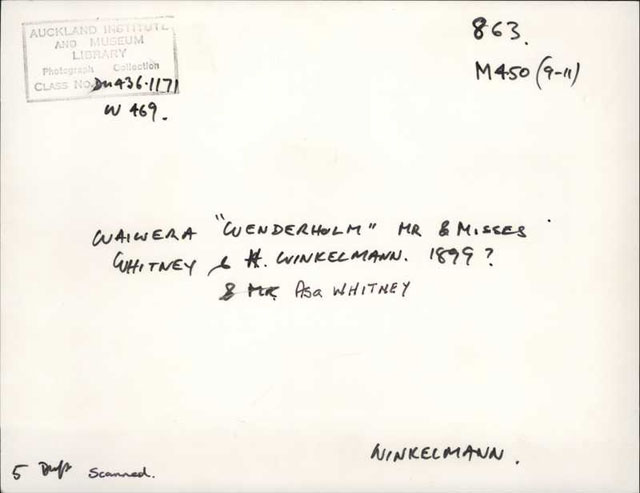
Auckland War Memorial Museum Tāmaki Paenga Hira. 47309-B
This mix-up between General Hogge and Captain Whitney seems to have been long-standing, probably going back to long before 2005; Vivien Edwards, Winkelmann's biographer, wrote in the Dictionary of New Zealand Biography (1996):
His [Winkelmann's] pictures sometimes showed humour, as in his portrait of Captain John Whitney at Wenderholm with a dog wearing spectacles. |
Vivien Edwards. 'Winkelmann, Henry', Dictionary of New Zealand Biography, first published in 1996. Te Ara - the Encyclopedia of New Zealand, https://teara.govt.nz/en/biographies/3w25/winkelmann-henry (accessed 15 May 2025)
In her much fuller and invaluable 1987 biography Winkelmann: Images of Early New Zealand (Benton Ross Publishers) Vivien Edwards reproduced the dog-with-glasses picture (page 32) and described Winkelmann taking "...an amusing photograph of himself and his hosts on the veranda of their house." Her use of the word "hosts" suggests that she may have been led to believe by the Museum's description that both Captain and Mrs Whitney were present in Winkelmann's group photograph.
Going further back in time, William Main in his wonderful book Auckland Through a Victorian Lens (Millwood Press, 1977) reproduced this photograph (acknowledging Auckland Museum) and wrote in his caption that in this picture Winkelmann was playing the auto-harp and that "Other members of his family seem to be giving him their undivided attention." How did William Main form the idea that this was Winkelmann's family? If he obtained a copy of the picture from the Museum for inclusion in his book (as seems very likely) did the Museum at that time also believe it showed Winkelmann's family? In any event, this suggests that the mistaken identification of General Hogge as "Mr" Whitney may not have yet been made.
Who were the "Misses Whitney"?
There were three Whitney daughters; the eldest, Aileen Muriel, married in 1896 (Observer 15 August 1896, page 14), three years before Winkelmann's visit. Given the extreme unlikelihood that she would in 1899 be termed "Miss" it seems very improbable that she was present on this occasion. The Whitney's second daughter was Amelia Viola Whitney and the youngest was Alice May Whitney.
A portrait of Alice was published in the 6 March 1897 issue of The New Zealand Graphic accompanying a report of her success as winner of the ladies’ shooting match at a meeting of the New Zealand Rifle Association (see below). Her skill in rifle shooting was unsurprising; her father, John Whitney, was a munitions manufacturer (he had founded the Colonial Ammunition Company) and her older sister Aileen (married name Lewis) was also considered "a good shot".

| Our Illustrations Miss Alice Whitney, the winner of the ladies’ shooting match at the recent meeting of the New Zealand Rifle Association, is the daughter of Captain Whitney, of Auckland. Her eldest sister, Mrs E.[sic] M. Lewis, has always been considered a good shot, and it was partly on account of Mrs Lewis’ departure from Auckland that Miss Alice Whitney consented to shoot in the match, she having had no previous practice with a Martini-Henry rifle until this match was announced. |
Auckland Libraries Heritage Collections NZG-18970306-0277-03; New Zealand Graphic, 6 March 1897, Page 287
Given Alice's features as evidenced in the New Zealand Graphic portrait, it doesn't look as if it's she who is seated on the veranda in the dog-with-glasses photograph above; it seems likely then that this Miss Whitney was Amelia Viola Whitney.
What was the dog reading?
Despite the sharpness and detail of Winkelmann's half-plate negative, it's very difficult to make much sense out of the document placed in front of the dog wearing glasses in plate 643. It seems to have been a rather worn and dog-eared (I know) newspaper or magazine with a two-word title or heading. Would it have been something that might have interested your average country dog? The content appears to have been some sort of illustration with stylised text—an advertisemt or cartoon perhaps? Below is a detail at 100 per cent scan resolution showing it rotated and with the perspective partially rectified. No amount of digital image enhancement, AI-assisted or not, has succeeded in making it readable. (The best I can do is that the stylised heading might be "The [something-beginning-with-R] Man".) Searching online lists of newspapers and periodicals current at the time hasn't produced any likely candidates.

Postscript
Below: Years after this 1899 weekend gathering, perhaps around 1915, John and Harriet Whitney were photographed in their garden by Vaughan Collett Cooper.
Wenderholm, Waiwera. John and Harriet Whitney
Click on image to toggle transition between two photographs
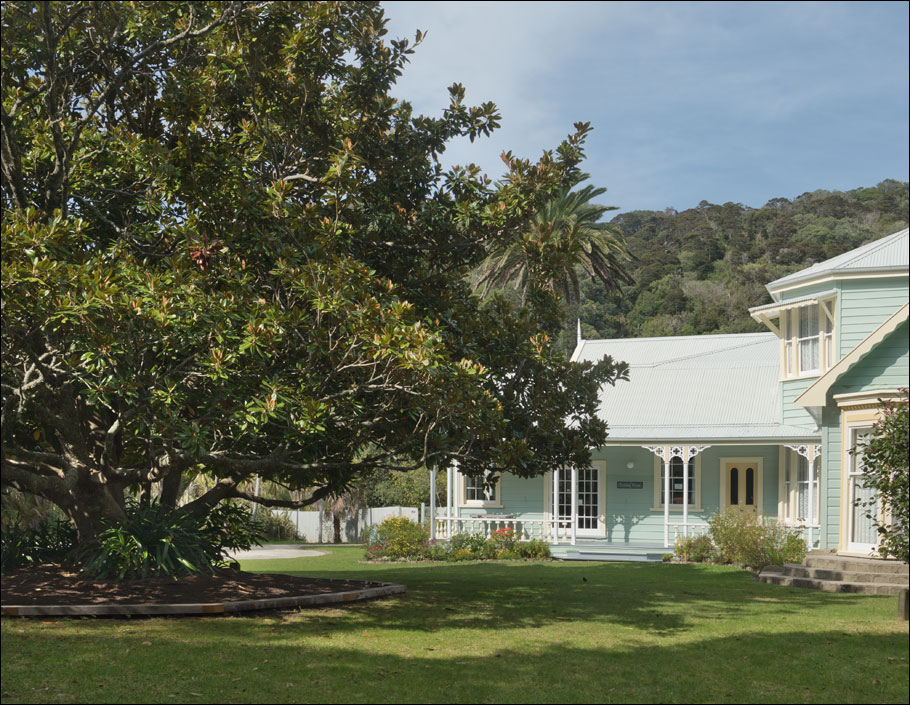

ca.1915 image: Vaughan Collett Cooper. Auckland War Memorial Museum Tāmaki Paenga Hira. PH-NEG-B2344.
Click here for a fullscreen version of this transition.
Below: The house today (2025), its form the result of many alterations and additions made over the years by a succession of owners. The veranda where Winkelmann made his group photograph (with the glasses-wearing dog) is at centre-right. Winkelmann's camera position would have been where there is a sunlit patch of lawn in front of this veranda.
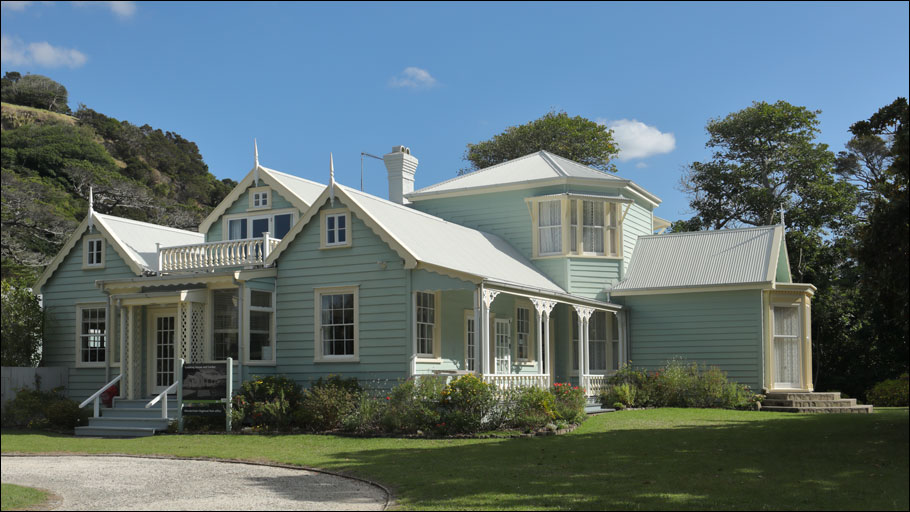
Below: Couldrey House dining room (2025). The dining table and chairs apparently date from the time of the Whitneys.
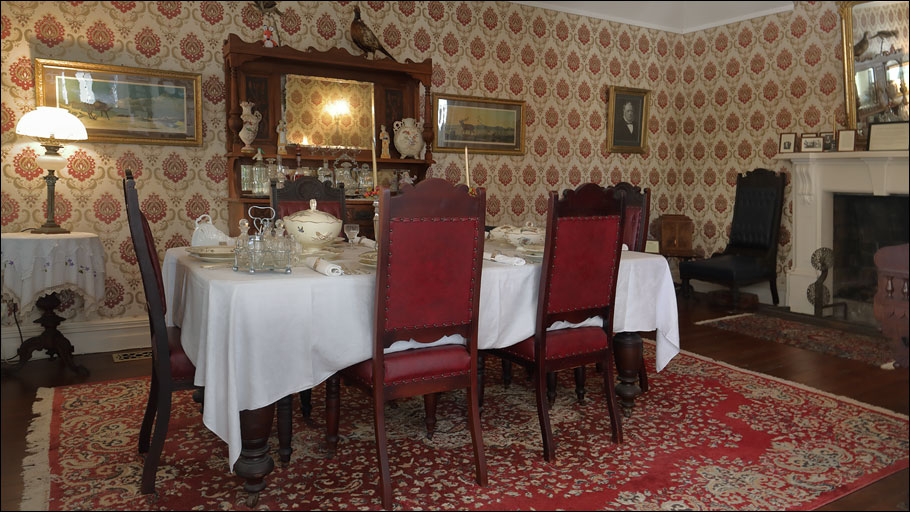
Looking back
Lastly, an extract from a 1933 obituary of John Whitney.
The house was very picturesque, set in amongst the native flora, tennis lawns and gardens. Situated on a flat, it is surrounded by bright gardens and fine level paddocks. The gardens in which there were a number of orange trees covered with bloom, as well as a lot of English and semi tropical shrubs, attracted the eye at once. There were beautiful lawns on either side, and a useful looking tennis court. In the well-kept paddocks behind the house were the horses, pony, donkey and cows; the latter were kept to supply the house with milk. Mrs Whitney used the donkey to carry her painting outfit to the places she desired to paint...she was a tall, beautiful woman, and, with a bunch of keys hanging at her waist, was quite the typical British chatelaine. Her welcome, like the Major’s was bright and it was evident she shared in his great hospitality, as well as in his love of nature... |
From "Wenderholm Regional Park: Our History". Lucy Mackintosh, Auckland Council booklet (2005, updated 2015)
Notes
- For some biographical information on General Hogge (including a reference to him being photographed by Winkelmann at Wenderholm in 1899) see this article from the Wainuiomata Historical Museum:
https://www.nzpictures.co.nz/WainuiMuseum-HoggeSomervilleGeorgeCameron.pdfHogge was a British army officer who apparently regularly visited New Zealand for fishing and shooting (in this he would have had much in common with John Whitney, and perhaps it was in this milieu—or through military connections— that they became acquainted).↩
- The expression on the face of the dog sitting in front of General Hogge, looking directly at the camera position suggests to me that one of the two Whitney daughters present (Alice, if I've correctly identified them) may have tripped the camera shutter; would the dog have looked in such an attentive way at an unattended camera? It could also explain the other Miss Whitney's absence from this second of two group photographs. Having said that, it could still of course be the case that Winkelmann had some sort of self-timer for his camera.↩
- The identification of "Mrs Gordon" in the group picture on the beach: She is not named in Winkelmann's negative register, so where did this information come from? The description "Four women, (includes 2 Misses Whitney and Mrs Gordon)" is an annotation written on the reverse of an Auckland Museum file print by an unknown hand. The Museum's Pictorial Collections Manager believes that at some time Winkelmann's negatives would have been in their original envelopes—which no longer exist—and that this may have been the source.↩
Below: Winkelmann's connection with the Whitneys would lead, three years after the 1899 visit to Wenderholm, to this photograph of John and Harriet Whitney's son CA Whitney, who had taken over the management of the Colonial Ammunition Company, in his Auckland office.
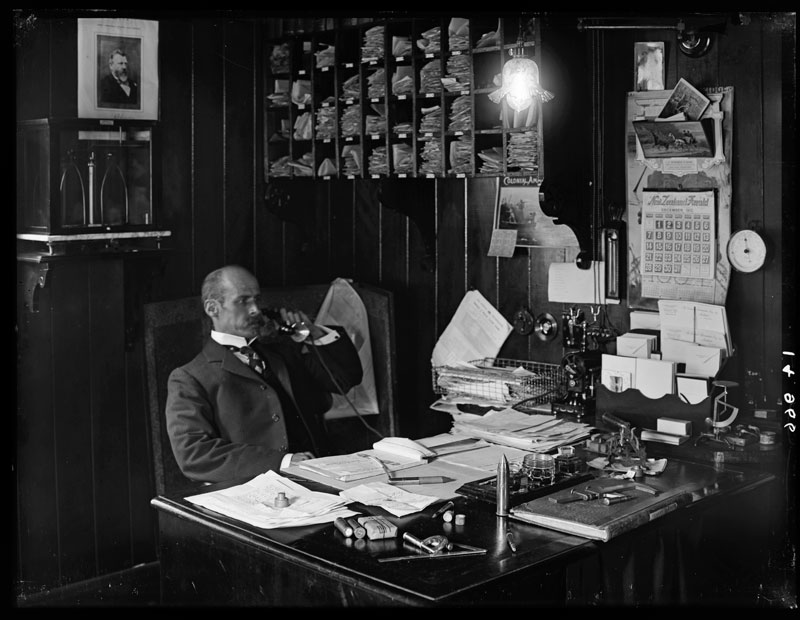
Henry Winkelmann, 1902. CAC office interior view - Mr. C.A. Whitney, manager. Auckland War Memorial Museum Tāmaki Paenga Hira. PH-NEG-14966_001
Below: This portrait of John Whitney (made about seven years after Winkelmann's 1899 visit) appeared in the New Zealand Graphic of 2 February 1907. (From around 1902 he had become known as Major Whitney.)
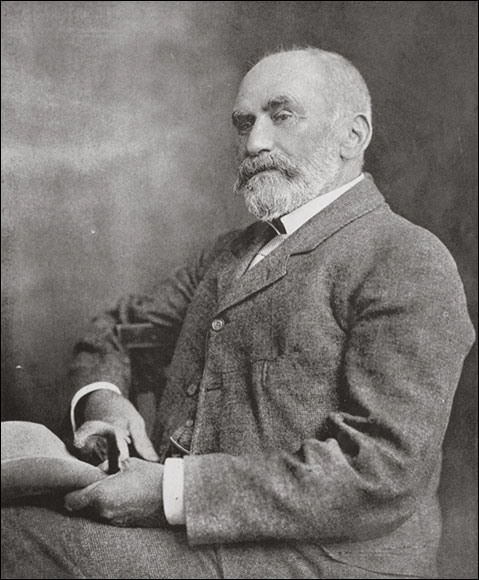
Auckland Libraries Heritage Collections NZG-19070202-0007-01
For a then-and-now treatment of a later Winkelmann photograph starring a dog, click here.